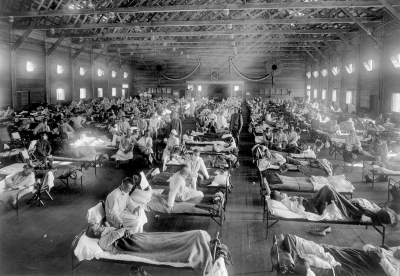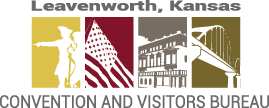Leavenworth during the 1918 Spanish Influenza
Leavenworth during the Spanish Flu pandemic
By Mary Ann Brown, April 11, 2020
Looking back one hundred years ago, U.S. citizens were emerging from the devastation caused by the 1918 and 1919 worldwide influenza pandemic, known as the Spanish flu. 500 million people had been infected, which at the time was about a quarter of the world’s population. The death toll count was only an estimate with a range of 17 up to 100 million.
Early press reports had minimized the illness and its mortality figures due to wartime censorship and the need to keep morale high during World War I. The Spanish flu was so named because Spain had remained neutral and their press was uncensored. Their reports, read by the rest of the world, triggered the assumption that the flu had begun in Spain. The Spanish, however, believed the virus had spread to them from France and hence, called it the French flu. While still not conclusive, scientists proposed in 2003 that the flu had actually originated in Haskell County, Kansas, early in 1918, and was carried to Camp Funston at Fort Reilly. It was here that new recruits were being trained for the war.
Regardless of the origin, the pandemic was the deadliest in world history since the bubonic plague. Then, as now, increased travel was a large factor in the spread of the virus. The U.S. was sending troops to Europe to fight in the war. Close quarters of troops hastened the transmission as did stress levels and undernourished soldiers in the field. Within the U.S. the railroads were the greatest disease spreaders.
What was it like in Leavenworth back then, one hundred years ago? Nurses visited homes for the purpose of investigation and instruction, in addition to the care of the sick. When schools were in session, daily examinations of children was conducted. By October 1918, Dr. T.B. H. Anderson of the Leavenworth public health department initiated an influenza quarantine under which public gatherings of every kind were prohibited. For two weeks Leavenworth was “closed” and not more than ten persons were allowed to gather together. Cases of influenza could double from day to day and consequently caused movie theaters, schools and churches to close, assemblies canceled, and homes quarantined when their residents fell ill.
Extreme care was urged in obeying all the rules laid down by the health department.
For those who first noticed symptoms, over-the-counter patent medicines were promoted as treatments and included such preparations as “Musterole”, “Hill’s Cascara Quinine Bromide”, “Dr. Bell’s Pine-Tar-Honey”, “Wizard Oil” or home-made remedies using turpentine & lard in addition to drinking elderberry tea. Bootleggers were bringing whiskey in from Missouri as “flu” medicine. Druggists were asked to conserve stocks of Vick’s Vapo-rub for use in “flu” hot spots. However, there was no cure and no vaccine for the flu.
During the second flu wave in 1919, Dr. Anderson declared, “We have positively prohibited, as far as is within our power, any children from mingling with crowds and thereby becoming exposed to the disease. Everyone older than that should have enough common sense not to expose himself by mixing in with a large crowd.” Streetcars were wiped down each night. Mrs. Besel enlisted four women to make masks from flannel, sewing 500 in one day. While flannel was thought to catch all germs, they were to be burned after a one-time use.
As waves of the epidemic had swept over the land, the advice was repeated in the Leavenworth Times in the spring of 1919:
-Keep your fingers out of your mouth. -Don’t shake hands with anybody but yourself. -Scrub your hands before meals. -Don’t patronize soda fountains that neglect to sterilize their glasses. -Keep your windows open and spend as much time as possible in the open air. -Avoid like you would a poisonous snake the person who is so uncouth as to spit promiscuously.
And, Dr. Anderson had the last word, “When the first symptoms of influenza are felt, it is high time the party starts for home at once, go to bed and remain there, resigned to stay there indefinitely.”
Finally, as quarantines were lifted, life slowly returned to normal, but with caution. Dr. Anderson continued to warn everyone to be careful. Leavenworth held a good record for weathering the epidemic. Rt. Rev. John Ward, Bishop of Leavenworth Diocese and Rev. Bernard S. Kelly had been making plans a year in advance for the 50th anniversary of the Immaculate Conception Cathedral, December 8, 1919. The celebration went on but six different services were held to avoid a crowded edifice. Social distancing became a consideration years ago.
We all would do well to heed the lessons of the past as history does indeed repeat itself.



